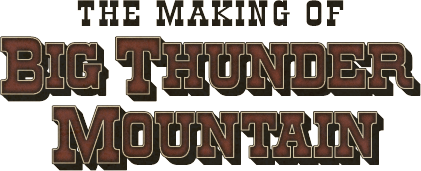
Nº 3 — East and Far East
Following the original plans, the Florida version of Big Thunder Mountain Railroad would be modeled after the iconic red buttes and mesas of Monument Valley, which had provided the majestic backdrop for countless Western movies.

This second incarnation of the attraction, featuring an extended queue line and a more expansive load building, provided Pat Burke with the opportunity to assemble an even greater roaster of props and accessories… and to further break with an old Disney mindset.
At the time when Disneyland first opened, amusement parks were generally seen as seedy, run-down collections of rides and exhibits. Walt Disney wanted to distance his own park from that perception. A famous case in point was the pristine-looking Haunted Mansion. “Even the old Mine Train through Nature’s Wonderland was really spic and span and no rust or stains,” Pat recalls.
Over time the Imagineers saw that audiences were able to distinguish between actual abandon and a carefully maintained, story-based aged look as you would apply to movie sets. Big Thunder Mountain Railroad, with its historic mining equipment, was an important step in that progress.

John Patrick Burke with one of his antique props, an authentic ball mill used to grind ore. Photo provided by J.P. Burke.
Several Imagineers had still to be convinced however, as Pat recounts. “The head painter called Marty Sklar and said I was turning the place into a junk yard with all my rusty artifacts.” Marty went to take a look with both Imagineers and was enthused by what he saw. “He thought it looked great!”
While the Californian attraction had its town of Big Thunder, left over from the defunct Mine Train through Nature’s Wonderland, the Floridian gold rush town of Tumbleweed required completely new show sets to be constructed. The Imagineers used the opportunity to add a whole new scene to the attraction, as the trains splashed and swayed through the flash flood-ridden town.

The town of Tumbleweed. Photo by Shawn Slater.
Next to the track they added the half-submerged wagon of one Professor Cumulus Isobar whose rainmaking machine seems to have caused all this mayhem… “The Rain Wagon was Tony’s idea and grew from his love of the George Pal movie The 7 Faces of Dr. Lao from 1964.”
During construction in 1979, it was real nature that held another surprise for the crew. When they drained the Frontierland river, they came across a number of big alligators and water snakes which had probably snuck in as babies when the park was built!

Big Thunder Mountain at Walt Disney World, Florida.
A few years later, in 1983, Tokyo Disneyland officially opened its gates as the first Disney theme park outside the United States and was an immediate success. Japanese audiences were so taken with the park that it took three years before any new attractions were deemed necessary. Big Thunder Mountain opened (without the “Railroad” extension to its name) as part of this first major expansion in 1987. In the meantime, the Imagineers had had some time to work on a number of improvements.
Imagineering legend John Hench added his own touch by adjusting the trains’ colors to achieve a more realistic look, quite different from the bright orange paint which graced the original vehicles. “John Hench helped us get texture added to the simulated wood car molds on the train,” Pat Burke explains.

A few changes were also given to the track layout, giving the ride a more exciting finale… Many of these enhancements would be brought to perfection in the next incarnation of the ride.

| 
